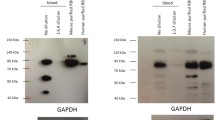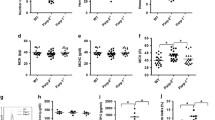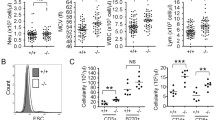Abstract
The transcription factor p53 suppresses tumor growth by inducing nucleated cell apoptosis and cycle arrest. Because of its influence on primitive erythroid cell differentiation and survival, p53 is an important determinant of erythropoiesis. However, the impact of p53 on the fate of erythrocytes, cells lacking nucleus and mitochondria, during their post-maturation phase in the circulation remained elusive. Erythrocyte survival may be compromised by suicidal erythrocyte death or eryptosis, which is hallmarked by phosphatidylserine translocation and stimulated by increase of cytosolic Ca2+ concentration. Here, we comparatively examined erythrocyte homeostasis in p53-mutant mice (Trp53tm1Tyj/J) and in corresponding WT mice (C57BL/6J) by analyzing eryptosis and erythropoiesis. To this end, spontaneous cell membrane phosphatidylserine exposure and cytosolic Ca2+ concentration were higher in erythrocytes drawn from Trp53tm1Tyj/J mice than from WT mice. Eryptosis induced by glucose deprivation, a pathophysiological cell stressor, was slightly, but significantly more prominent in erythrocytes drawn from Trp53tm1Tyj/J mice as compared to WT mice. The loss of erythrocytes by eryptosis was fully compensated by enhanced erythropoiesis in Trp53tm1Tyj/J mice, as reflected by increased reticulocytosis and abundance of erythroid precursor cells in the bone marrow. Accordingly, erythrocyte number, packed cell volume and hemoglobin were similar in Trp53tm1Tyj/J and WT mice. Taken together, functional p53 deficiency enhances the turnover of circulating erythrocytes by parallel increase of eryptosis and stimulated compensatory erythropoiesis.






Similar content being viewed by others
References
Ferraiuolo M, Di Agostino S, Blandino G, Strano S (2016) Oncogenic intra-p53 family member interactions in human cancers. Front Oncol 6:77
Pant V, Quintas-Cardama A, Lozano G (2012) The p53 pathway in hematopoiesis: lessons from mouse models, implications for humans. Blood 120:5118–5127
Beckta JM, Ahmad SF, Yang H, Valerie K (2014) Revisiting p53 for cancer-specific chemo- and radiotherapy: ten years after. Cell Cycle 13:710–713
Feng Z, Hu W, Rajagopal G, Levine AJ (2008) The tumor suppressor p53: cancer and aging. Cell Cycle 7:842–847
Levine AJ (2017) The p53 protein plays a central role in the mechanism of action of epigentic drugs that alter the methylation of cytosine residues in DNA. Oncotarget 8:7228–7230
Kojima K, Ishizawa J, Andreeff M (2016) Pharmacological activation of wild-type p53 in the therapy of leukemia. Exp Hematol 44:791–798
Napoli M, Flores ER (2017) The p53 family orchestrates the regulation of metabolism: physiological regulation and implications for cancer therapy. Br J Cancer 116:149–155
Hientz K, Mohr A, Bhakta-Guha D, Efferth T (2017) The role of p53 in cancer drug resistance and targeted chemotherapy. Oncotarget 8:8921–8946
Reinhardt HC, Schumacher B (2012) The p53 network: cellular and systemic DNA damage responses in aging and cancer. Trends Genet 28:128–136
Chen J (2016) The cell-cycle arrest and apoptotic functions of p53 in tumor initiation and progression. Cold Spring Harb Perspect Med 6:a026104
Kung CP, Murphy ME (2016) The role of the p53 tumor suppressor in metabolism and diabetes. J Endocrinol 231:R61–R75
Cooks T, Harris CC, Oren M (2014) Caught in the cross fire: p53 in inflammation. Carcinogenesis 35:1680–1690
Ganguli G, Back J, Sengupta S, Wasylyk B (2002) The p53 tumour suppressor inhibits glucocorticoid-induced proliferation of erythroid progenitors. EMBO Rep 3:569–574
Vemula S, Shi J, Mali RS, Ma P, Liu Y, Hanneman P, Koehler KR, Hashino E, Wei L, Kapur R (2012) ROCK1 functions as a critical regulator of stress erythropoiesis and survival by regulating p53. Blood 120:2868–2878
Caceres G, McGraw K, Yip BH, Pellagatti A, Johnson J, Zhang L, Liu K, Zhang LM, Fulp WJ, Lee JH, Al Ali NH, Basiorka A, Smith LJ, Daugherty FJ, Littleton N, Wells RA, Sokol L, Wei S, Komrokji RS, Boultwood J, List AF (2013) TP53 suppression promotes erythropoiesis in del(5q) MDS, suggesting a targeted therapeutic strategy in lenalidomide-resistant patients. Proc Natl Acad Sci USA 110:16127–16132
Lang E, Qadri SM, Lang F (2012) Killing me softly—suicidal erythrocyte death. Int J Biochem Cell Biol 44:1236–1243
Lang F, Qadri SM (2012) Mechanisms and significance of eryptosis, the suicidal death of erythrocytes. Blood Purif 33:125–130
Qadri SM, Bissinger R, Solh Z, Oldenborg PA (2017) Eryptosis in health and disease: a paradigm shift towards understanding the (patho)physiological implications of programmed cell death of erythrocytes. Blood Rev 31:349–361
Pretorius E, du Plooy JN, Bester J (2016) A comprehensive review on eryptosis. Cell Physiol Biochem 39:1977–2000
Bissinger R, Bhuyan AAM, Qadri SM, Lang F (2018) Oxidative stress, eryptosis and anemia: a pivotal mechanistic nexus in systemic diseases. FEBS J. https://doi.org/10.1111/febs.14606
Jacks T, Remington L, Williams BO, Schmitt EM, Halachmi S, Bronson RT, Weinberg RA (1994) Tumor spectrum analysis in p53-mutant mice. Curr Biol 4:1–7
Bissinger R, Lang E, Ghashghaeinia M, Singh Y, Zelenak C, Fehrenbacher B, Honisch S, Chen H, Fakhri H, Umbach AT, Liu G, Rexhepaj R, Liu G, Schaller M, Mack AF, Lupescu A, Birnbaumer L, Lang F, Qadri SM (2016) Blunted apoptosis of erythrocytes in mice deficient in the heterotrimeric G-protein subunit Gαi2. Sci Rep 6:30925
Jemaa M, Fezai M, Bissinger R, Lang F (2017) Methods employed in cytofluorometric assessment of eryptosis, the suicidal erythrocyte death. Cell Physiol Biochem 43:431–444
Lang E, Bissinger R, Fajol A, Salker MS, Singh Y, Zelenak C, Ghashghaeinia M, Gu S, Jilani K, Lupescu A, Reyskens KM, Ackermann TF, Foller M, Schleicher E, Sheffield WP, Arthur JS, Lang F, Qadri SM (2015) Accelerated apoptotic death and in vivo turnover of erythrocytes in mice lacking functional mitogen- and stress-activated kinase MSK1/2. Sci Rep 5:17316
Sayed Ael D, Watanabe-Asaka T, Oda S, Mitani H (2016) Apoptosis and morphological alterations after UVA irradiation in red blood cells of p53 deficient Japanese medaka (Oryzias latipes). J Photochem Photobiol B 161:1–8
Lang E, Bissinger R, Qadri SM, Lang F (2017) Suicidal death of erythrocytes in cancer and its chemotherapy: a potential target in the treatment of tumor-associated anemia. Int J Cancer 141:1522–1528
Qadri SM, Mahmud H, Lang E, Gu S, Bobbala D, Zelenak C, Jilani K, Siegfried A, Foller M, Lang F (2012) Enhanced suicidal erythrocyte death in mice carrying a loss-of-function mutation of the adenomatous polyposis coli gene. J Cell Mol Med 16:1085–1093
Bissinger R, Schumacher C, Qadri SM, Honisch S, Malik A, Gotz F, Kopp HG, Lang F (2016) Enhanced eryptosis contributes to anemia in lung cancer patients. Oncotarget 7:14002–14014
Bissinger R, Artunc F, Qadri SM, Lang F (2016) Reduced erythrocyte survival in uremic patients under hemodialysis or peritoneal dialysis. Kidney Blood Press Res 41:966–977
Lang E, Gatidis S, Freise NF, Bock H, Kubitz R, Lauermann C, Orth HM, Klindt C, Schuier M, Keitel V, Reich M, Liu G, Schmidt S, Xu HC, Qadri SM, Herebian D, Pandyra AA, Mayatepek E, Gulbins E, Lang F, Haussinger D, Lang KS, Foller M, Lang PA (2015) Conjugated bilirubin triggers anemia by inducing erythrocyte death. Hepatology 61:275–284
Lang E, Pozdeev VI, Gatidis S, Qadri SM, Haussinger D, Kubitz R, Herebian D, Mayatepek E, Lang F, Lang KS, Lang PA (2016) Bile acid-induced suicidal erythrocyte death. Cell Physiol Biochem 38:1500–1509
Kempe-Teufel DS, Bissinger R, Qadri SM, Wagner R, Peter A, Lang F (2018) Cellular markers of eryptosis are altered in type 2 diabetes. Clin Chem Lab Med 56:e177–e180. https://doi.org/10.1515/cclm-2017-1058
Bissinger R, Kempe-Teufel DS, Honisch S, Qadri SM, Randrianarisoa E, Haring HU, Henes J, Lang F (2016) Stimulated suicidal erythrocyte death in arteritis. Cell Physiol Biochem 39:1068–1077
Qadri SM, Donkor DA, Bhakta V, Eltringham-Smith LJ, Dwivedi DJ, Moore JC, Pepler L, Ivetic N, Nazi I, Fox-Robichaud AE, Liaw PC, Sheffield WP (2016) Phosphatidylserine externalization and procoagulant activation of erythrocytes induced by Pseudomonas aeruginosa virulence factor pyocyanin. J Cell Mol Med 20:710–720
Jiang P, Bian M, Ma W, Liu C, Yang P, Zhu B, Xu Y, Zheng M, Qiao J, Shuai Z, Zhou X, Huang D (2016) Eryptosis as an underlying mechanism in systemic lupus erythematosus-related anemia. Cell Physiol Biochem 40:1391–1400
Shan F, Yang R, Ji T, Jiao F (2016) Vitamin C inhibits aggravated eryptosis by hydrogen peroxide in glucose-6-phosphated dehydrogenase deficiency. Cell Physiol Biochem 39:1453–1462
Bartolmas T, Mayer B, Balola AH, Salama A (2017) Eryptosis in autoimmune haemolytic anaemia. Eur J Haematol 100:36–44
Lang E, Jilani K, Bissinger R, Rexhepaj R, Zelenak C, Lupescu A, Lang F, Qadri SM (2015) Vitamin D-rich diet in mice modulates erythrocyte survival. Kidney Blood Press Res 40:403–412
Lupescu A, Bissinger R, Goebel T, Salker MS, Alzoubi K, Liu G, Chirigiu L, Mack AF, Qadri SM, Lang F (2015) Enhanced suicidal erythrocyte death contributing to anemia in the elderly. Cell Physiol Biochem 36:773–783
Lang F, Bissinger R, Abed M, Artunc F (2017) Eryptosis—the neglected cause of anemia in end stage renal disease. Kidney Blood Press Res 42:749–760
Al Mamun Bhuyan A, Bissinger R, Cao H, Lang F (2017) Triggering of suicidal erythrocyte death by exemestane. Cell Physiol Biochem 42:1–12
Al Mamun Bhuyan A, Cao H, Lang F (2017) Triggering of eryptosis, the suicidal erythrocyte death by mammalian target of rapamycin (mTOR) inhibitor temsirolimus. Cell Physiol Biochem 42:1575–1591
Al Mamun Bhuyan A, Nguyen MT, Bissinger R, Gotz F, Lang F (2017) Lipopeptide-induced suicidal erythrocyte death correlates with the degree of acylation. Cell Physiol Biochem 41:296–309
Qadri SM, Donkor DA, Nazy I, Branch DR, Sheffield WP (2018) Bacterial neuraminidase-mediated erythrocyte desialylation provokes cell surface aminophospholipid exposure. Eur J Haematol 100:502–510
Ghashghaeinia M, Wesseling MC, Ramos E, Petkova-Kirova P, Waibel S, Lang E, Bissinger R, Alzoubi K, Edelmann B, Hosseinzadeh Z, Dreischer P, Shahvaroughi-Farahani A, Mrowietz U, Koberle M, Kaestner L, Bernhardt I, Martinez-Ruiz A, Wieder T, Lang F (2017) Trifluoperazine-induced suicidal erythrocyte death and S-nitrosylation inhibition, reversed by the nitric oxide donor sodium nitroprusside. Cell Physiol Biochem 42:1985–1998
Signoretto E, Zierle J, Bissinger R, Castagna M, Bossi E, Lang F (2016) Triggering of suicidal erythrocyte death by pazopanib. Cell Physiol Biochem 38:926–938
Mischitelli M, Jemaaa M, Fezai M, Almasry M, Lang F, Faggio C (2017) Stimulation of erythrocyte cell membrane scrambling by adarotene. Cell Physiol Biochem 41:519–529
Almasry M, Jemaa M, Mischitelli M, Faggio C, Lang F (2016) Stimulation of suicidal erythrocyte death by phosphatase inhibitor calyculin A. Cell Physiol Biochem 40:163–171
Jemaa M, Mischitelli M, Fezai M, Almasry M, Faggio C, Lang F (2016) Stimulation of suicidal erythrocyte death by the CDC25 inhibitor NSC-95397. Cell Physiol Biochem 40:597–607
Mischitelli M, Jemaa M, Almasry M, Faggio C, Lang F (2016) Triggering of erythrocyte cell membrane scrambling by emodin. Cell Physiol Biochem 40:91–103
Al Mamun Bhuyan A, Wagner T, Cao H, Lang F (2017) Triggering of suicidal erythrocyte death by gefitinib. Cell Physiol Biochem 41:1697–1708
Al Mamun Bhuyan A, Signoretto E, Bissinger R, Lang F (2016) Enhanced eryptosis following exposure to dolutegravir. Cell Physiol Biochem 39:639–650
Lupescu A, Shaik N, Jilani K, Zelenak C, Lang E, Pasham V, Zbidah M, Plate A, Bitzer M, Foller M, Qadri SM, Lang F (2012) Enhanced erythrocyte membrane exposure of phosphatidylserine following sorafenib treatment: an in vivo and in vitro study. Cell Physiol Biochem 30:876–888
Lang E, Pozdeev VI, Xu HC, Shinde PV, Behnke K, Hamdam JM, Lehnert E, Scharf RE, Lang F, Haussinger D, Lang KS, Lang PA (2016) Storage of erythrocytes induces suicidal erythrocyte death. Cell Physiol Biochem 39:668–676
Qadri SM, Chen D, Schubert P, Devine DV, Sheffield WP (2017) Early gamma-irradiation and subsequent storage of red cells in SAG-M additive solution potentiate energy imbalance, microvesiculation and susceptibility to stress-induced apoptotic cell death. Vox Sang 112:480–483
Qadri SM, Chen D, Schubert P, Perruzza DL, Bhakta V, Devine DV, Sheffield WP (2017) Pathogen inactivation by riboflavin and ultraviolet light illumination accelerates the red blood cell storage lesion and promotes eryptosis. Transfusion 57:661–673
Zelenak C, Foller M, Velic A, Krug K, Qadri SM, Viollet B, Lang F, Macek B (2011) Proteome analysis of erythrocytes lacking AMP-activated protein kinase reveals a role of PAK2 kinase in eryptosis. J Proteome Res 10:1690–1697
Gatidis S, Zelenak C, Fajol A, Lang E, Jilani K, Michael D, Qadri SM, Lang F (2011) p38 MAPK activation and function following osmotic shock of erythrocytes. Cell Physiol Biochem 28:1279–1286
Zelenak C, Eberhard M, Jilani K, Qadri SM, Macek B, Lang F (2012) Protein kinase CK1α regulates erythrocyte survival. Cell Physiol Biochem 29:171–180
Kucherenko Y, Zelenak C, Eberhard M, Qadri SM, Lang F (2012) Effect of casein kinase 1α activator pyrvinium pamoate on erythrocyte ion channels. Cell Physiol Biochem 30:407–417
Lang E, Zelenak C, Eberhard M, Bissinger R, Rotte A, Ghashghaeinia M, Lupescu A, Lang F, Qadri SM (2015) Impact of cyclin-dependent kinase CDK4 inhibition on eryptosis. Cell Physiol Biochem 37:1178–1186
Qadri SM, Bauer J, Zelenak C, Mahmud H, Kucherenko Y, Lee SH, Ferlinz K, Lang F (2011) Sphingosine but not sphingosine-1-phosphate stimulates suicidal erythrocyte death. Cell Physiol Biochem 28:339–346
Lang E, Lang PA, Shumilina E, Qadri SM, Kucherenko Y, Kempe DS, Foller M, Capasso A, Wieder T, Gulbins E, Clemen CS, Herr C, Noegel AA, Huber SM, Lang F (2010) Enhanced eryptosis of erythrocytes from gene-targeted mice lacking annexin A7. Pflugers Arch 460:667–676
Borst O, Abed M, Alesutan I, Towhid ST, Qadri SM, Foller M, Gawaz M, Lang F (2012) Dynamic adhesion of eryptotic erythrocytes to endothelial cells via CXCL16/SR-PSOX. Am J Physiol Cell Physiol 302:C644–C651
Larsson A, Hult A, Nilsson A, Olsson M, Oldenborg PA (2016) Red blood cells with elevated cytoplasmic Ca(2+) are primarily taken up by splenic marginal zone macrophages and CD207 + dendritic cells. Transfusion 56:1834–1844
Acknowledgements
The authors thank Prof. Lars Zender, Dr. Tae-Won Kang and their laboratory members (Department of Vegetative & Clinical Physiology, University of Tübingen, Germany) for their valuable suggestions and for providing samples from Trp53tm1Tyj/J mice. The study was supported by the Deutsche Forschungsgemeinschaft (DFG) to FL, EU Systems Biology to Identify Molecular Targets for Vascular Disease Treatment (SysVasc), HEALTH-2013 603288 to LP, and the Open Access Publishing Fund of the University of Tuebingen. Work of RB is supported by the Institutional Strategy of the University of Tuebingen (Deutsche Forschungsgemeinschaft, ZUK63). SMQ was supported by resources from Canadian Blood Services. As a condition of Canadian government funding, this report must contain the statement, “The views expressed herein do not necessarily represent the view of the federal government of Canada.”
Author information
Authors and Affiliations
Corresponding authors
Ethics declarations
Conflict of interest
The authors declare no potential conflicts of interest.
Rights and permissions
About this article
Cite this article
Bissinger, R., Lang, E., Gonzalez-Menendez, I. et al. Genetic deficiency of the tumor suppressor protein p53 influences erythrocyte survival. Apoptosis 23, 641–650 (2018). https://doi.org/10.1007/s10495-018-1481-8
Published:
Issue Date:
DOI: https://doi.org/10.1007/s10495-018-1481-8




